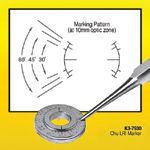Article
Marker, knife useful additions to refractive cataract surgeons' armamentarium
Two new instruments designed by Y. Ralph Chu, MD, and available from Katena Eye Instruments are useful aids for cataract surgeons performing limbal relaxing incisions.

Key Points


The Chu LRI Marker has a very low-profile degree gauge that allows it to sit easily on the cornea and affords good visualization of the pupil center and limbal reference marks. The degree gauge has a rotating head for aligning the pattern along the axis of astigmatism that is marked in 10° increments and also features 30°, 45°, and 60° landmarks.
"There are a lot of good markers for use in performing arcuate keratotomies and LRIs, but one of the problems with these inked instruments is that the ink smears on the cornea," noted Dr. Chu. "The smudged lines interfere with intraoperative visualization and can reduce the accuracy of the LRIs."
On the Chu LRI marker, the delineating "teeth" marks are ultrathin and very sharp so that when the marker is pressed onto the cornea, a clear pattern of fine indentations is left as a guide for the incisions. The marks remain clearly visible even with the eye rotating up during surgery and after BSS irrigation.
Impression of the Chu LRI marker onto the cornea produces lines marking the axis, hashmarks delineating the 30°, 45°, and 60° arc lengths, as well as arcuate marks delineating the LRIs.
"Rather than working between two hashmarks, surgeons can literally trace these arcs with the diamond knife to create precise LRIs for accurate results," said Dr. Chu.
The marker is aligned intraoperatively using previously placed reference marks or anatomic landmarks. It is best applied to a dry cornea as an initial step in the surgery, when the eye is at its firmest and will yield the most consistent results.
As a companion to the new marker, Dr. Chu suggested a design for a new dual-function LRI diamond knife that can be used for creating both the limbal relaxing and paracentesis incisions. The Chu LRI diamond knife has a 600-μm preset depth and extends to 2.5 mm. It also features a guard that prevents the blade from being pushed too far when being used at full extension so that the surgeon does not inadvertently nick the anterior capsule.
"This is a nice safety feature considering that diamond blades are so sharp and the cornea provides little resistance," said Dr. Chu.
Newsletter
Don’t miss out—get Ophthalmology Times updates on the latest clinical advancements and expert interviews, straight to your inbox.




